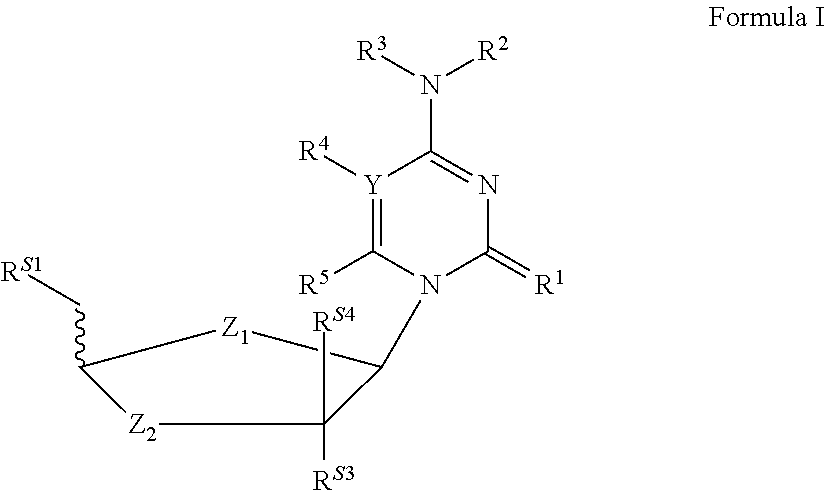Enzymatic production of cytosinic nucleoside analogues
a technology of cytosine nucleoside and cytosine, which is applied in the preparation of sugar derivatives, sugar derivates, sugar derivatives, etc., can solve the problems of low yield, increased cost, and chemical methods that increase the difficulty of obtaining products with correct stereo- and regioselectivity
- Summary
- Abstract
- Description
- Claims
- Application Information
AI Technical Summary
Benefits of technology
Problems solved by technology
Method used
Image
Examples
example 1
Synthesis of 5-Fluoro-5′-Deoxycytidine Departing from Unmodified 5-Fluorocytosine and Deoxyuridine
[0295]A solution of 2.5 mM 5-fluorocytosine and 8.0 mM 5′-deoxyuridine in 30 mM aqueous phosphate buffer at pH 7 and 10% DMSO was heated at 600° C. during 30 min. Then, PyNP (5.4 U / μmolbase, was added and the reaction was stirred at 60° C. during 4 hours under the same conditions. Then, the crude reaction was filtered through a 10 KDa membrane, and a portion was diluted and analyzed by HPLC. The expected product 5-Fluoro-5′-deoxycytidine was not detected by UV-DAD (ultraviolet-diode array detection).
example 2
Synthesis of 5-Fluoro-5′-Deoxycytidine Departing from Unmodified 5-Fluorocytosine and Chloro-5′-Deoxyuridine
[0296]A solution of 2.5 mM 5-fluorocytosine and 8.6 mM 5-chloro-5′-deoxyuridine in 30 mM aqueous phosphate buffer at pH 7 and 10% DMSO was heated at 60° C. during 30 min. Then, PyNP (5.4 U / μmolbase) was added and the reaction was stirred at 60° C. during 4 hours under the same conditions. Then, the crude reaction was filtered through a 10 KDa membrane, and a portion was diluted and analyzed by HPLC. The expected product 5-Fluoro-5′-deoxycytidine was not detected by UV-DAD.
example 3
Synthesis of Cytarabine Departing from Unmodified Cytosine and Arabinofuranosyluracil
[0297]A solution of 3.0 mM cytosine and 10 mM 9-(b-D-arabinofuranosyl)uracil in 30 mM aqueous phosphate buffer at pH 7 and 10% DMSO was heated at 60° C. during 30 min. Then, PyNP (4.4 U / μmolbase) was added and the reaction was stirred at 60° C. during 4 hours under the same conditions. Then, the crude reaction was filtered through a 10 KDa membrane, and a portion was diluted and analyzed by HPLC. The expected product 1-(b-D-arabinofuranosyl)cytosine (Cytarabine) was not detected by UV-DAD, but uracil from cytosine decomposition through deamination was obtained.
PUM
| Property | Measurement | Unit |
|---|---|---|
| temperature | aaaaa | aaaaa |
| temperatures | aaaaa | aaaaa |
| temperatures | aaaaa | aaaaa |
Abstract
Description
Claims
Application Information
 Login to View More
Login to View More - R&D
- Intellectual Property
- Life Sciences
- Materials
- Tech Scout
- Unparalleled Data Quality
- Higher Quality Content
- 60% Fewer Hallucinations
Browse by: Latest US Patents, China's latest patents, Technical Efficacy Thesaurus, Application Domain, Technology Topic, Popular Technical Reports.
© 2025 PatSnap. All rights reserved.Legal|Privacy policy|Modern Slavery Act Transparency Statement|Sitemap|About US| Contact US: help@patsnap.com



